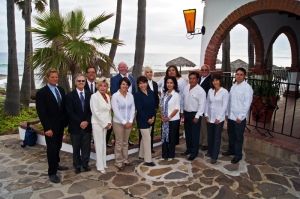BY ANDRES OPPENHEIMER
aoppenheimer@MiamiHerald.com

Mexico's big hope: get 5 million U.S. retirees
MEXICO CITY — Mexico is silently working on proposals aimed at drawing millions of U.S. retirees to this country, which could eventually lead to the most ambitious U.S.-Mexican project since the 1994 North American Free Trade Agreement.
President Felipe Calderón is likely to propose the first steps toward expanding U.S. retirement benefits and medical tourism to Mexico when he goes to Washington on an official visit May 19, according to well-placed officials here. If not then, he will raise the issue later this year, they say.
“It’s one of the pillars of our plans to trigger economic and social well-being in both countries,” Mexico’s ambassador to the United States Arturo Sarukhan told me. “We will be seeking to increasingly discuss this issue in coming months and years.”
Calderón brought it up during a U.S.-Canada-Mexico summit in Guadalajara in August last year, but President Barack Obama asked him to shelve the idea until he was able to pass healthcare reform, another official told me.
Now that Congress has passed healthcare reform, Calderón is preparing to charge ahead.
A GROWING MARKET
There are already an estimated 1 million Americans living in Mexico. And according to Mexican government estimates based on U.S. Census figures, that number is likely to soar to 5 million by 2025 as the U.S. population grows older and more Americans look for sunny, cheaper places to retire.
The U.S. Census projects that the number of U.S. retirees will soar from 40 million now to nearly 90 million by 2050. Already, 5 million American retirees live abroad, of whom 2.2 million are in the Western Hemisphere — mostly in Mexico, the Dominican Republic and Brazil. Another 1.5 million live in Europe and 850,000 in Asia.
The key to luring more U.S. medical tourists and retirees to Mexico and other Latin American countries will be getting hospitals in the region to be certified by the U.S. Joint International Commission, which establishes that they meet U.S. hospitals’ standards. There are already eight Mexican hospitals certified by the JIC and several others awaiting certification.
According to Mexican government estimates, healthcare costs in Mexico are about 70 percent lower than in the United States. And from my own experience, those estimates are right: As I reported at the time, when I was hospitalized in Mexico two years ago for an emergency operation, my hospital bill was indeed about 70 percent lower than what it would have been in Miami.
So what will Calderón specifically propose to Obama? Most likely, the Mexican president will suggest starting with a low-profile agreement that would allow the U.S. Health Care Financing Administration to pay for Medicare benefits to U.S. retirees in Mexico. Under current rules, Medicare only covers healthcare services in the United States.
IT JUST MAKES SENSE
My opinion: Mexico and much of Latin America are bound to become growing U.S. retirement and medical tourism destinations, much like Spain has become a permanent living place for Germans, Britons and Northern Europeans.
You won’t read much about it now because neither Calderón nor Obama will emphasize it publicly while the drug-related violence in northern Mexico is making big headlines, and while the political wounds from the recent U.S. healthcare debate are still open in Washington, D.C.
But I’m increasingly convinced that, as the violence in Mexico subsides and the healthcare debate becomes a distant memory in Washington, medical benefits’ deals will become a top U.S.-Latin American priority. Just as free-trade agreements were the big thing of the 1990s, healthcare agreements will be the big deal of the coming decade.
I wouldn’t be surprised if Calderón and Obama take the first baby steps toward a U.S.-Mexico healthcare agreement by finding a way to pay for Medicare benefits for U.S. expatriates in Mexico, or getting U.S. states to allow similar payments. Then, most likely after the 2012 presidential election in both countries, the two would start negotiating a more ambitious deal.
Demography, geography and economics are pointing in that direction. With the U.S. population getting older, a record U.S. budget deficit, rising U.S. healthcare costs, and Mexico and other Latin American countries badly needing more tourism and investments, this should be a win-win for everybody.
—
Browse for real estate in mexico.








